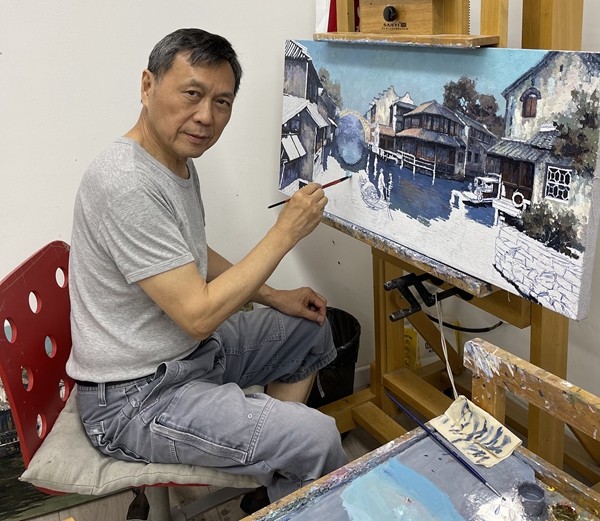
Professor Wang Qijun of the Beijing-based Central Academy of Fine Arts works in his studio. Three dictionaries he compiled about Chinese and Western architecture have been republished.[Photo provided to China Daily]
Three volumes examine Chinese and Western architecture in detail, Huang Zhiling reports.
Beijing hosts a number of architectural styles from soaring skyscrapers to ancient buildings. It has married the modern with the traditional. Visitors to the Forbidden City in the city center can sample and appreciate the delights of master craftsmen with their ancient skills on show amid the rumble of traffic.
Likewise, visitors to the Summer Palace in the capital's western suburbs are also in for a treat, not least in its winding gardens.
The Forbidden City, which was included on the UNESCO World Cultural Heritage list in 1987, was the imperial palace of the Ming and Qing dynasties (1368-1911). Its construction started in 1406 and was completed in 1420.
Together with Versailles Palace in France, Buckingham Palace in Britain, the White House in the United States, and the Kremlin in Russia, it is referred to as one of the major historic buildings in the world.
Built between 1886-94, the Summer Palace is China's best preserved royal garden. In 1998, UNESCO included the palace on its World Cultural Heritage list, hailing it as "a masterpiece of Chinese landscape garden design". It added that "the natural landscape of hills and open water is combined with artificial features such as pavilions, halls, palaces, temples and bridges to form a harmonious ensemble of outstanding aesthetic value".
Chinese architectural style is unique, and has radiated its influence on countries in East Asia and South Asia.
Traditional Chinese architecture has many complex components and stunning visual images.
How can people understand the intricacies of ancient Chinese architecture? Do they have to learn about it in a school of architecture or in an institution of higher learning?
Help is at hand, literally. Compiled by Wang Qijun, a professor of the Beijing-based Central Academy of Fine Arts, An Illustrated Dictionary of Chinese Architecture, An Illustrated Dictionary of Chinese Gardens and An Illustrated Dictionary of Western Architecture have been republished by China Machine Press.

The three dictionaries Wang Qijun compiled- An Illustrated Dictionary of Chinese Architecture(right), An Illustrated Dictionary of Chinese Gardensand An Illustrated Dictionary of Western Architecture(left).[Photo provided to China Daily]
The three dictionaries act like a mysterious pair of glasses through which readers can not only understand ancient Chinese architecture and gardens, but also expand their international perspective, and have a glimpse of global architectural culture, critics say.
What is striking about the three dictionaries is that they have more than 3,000 hand-painted color illustrations which give a comprehensive picture of relevant buildings.
For example, the shape and details of the Forbidden City, Summer Palace, gardens in Jiangnan (a name that describes the areas south of the Yangtze River which is known for beautiful scenery), Eight Outer Temples and Basilica di San Marco in Venice can be clearly restored by the hand-painted color illustrations, and even their internal structures that the camera cannot shoot have been reproduced.
To the northeast of the Mountain Resort of Chengde in Hebei province, lies the Eight Outer Temples, the emperor's summer residence during the Qing Dynasty (1644-1911). Together with the Mountain Resort of Chengde, the temples were included on the UNESCO World Cultural Heritage list in 1994.
Opening the dictionaries, one can find the illustrations are like flowers. Children who like to draw can also use these illustrations as an ideal way to learn painting. With a doctor's degree in architecture at Tsinghua University, Wang began to draw the illustrations in the early 1990s. After decades of accumulation, the hand-painted illustrations have found their way into the three dictionaries.
Since the dictionaries were published by China Machine Press in 2006, they have been reprinted for more than 70 times and sold more than 100,000 copies, according to Southern People Weekly.
Since their republishing, the dictionaries have been popular with those who are interested in architecture, according to Wei Bing, an architect in Chengdu, Sichuan province.
"The three dictionaries will be placed at an easy-to-spot position on my bookcase. If they are not there, they must have been taken out for reading when I travel," he says.
Each of the dictionaries is only 13 centimeters wide, and is easy for adults to hold in one hand. The length of each dictionary is 22 cm, and a small handbag can hold it.
It is convenient to take one of the dictionaries to the subway or a bus and during travel, Wei says.
According to Zhao Rong, publisher of the three dictionaries, they have been published in Chinese and Korean. They will also be published in Vietnamese, Japanese and Russian.
Born in Xuzhou, Jiangsu province, in 1954, Wang is hailed as one of the 60 most influential Chinese painters after the founding of the People's Republic of China in 1949 in a 60-volume Chinese art documentary, Classics and Immortality, sponsored by the Publicity Department of the Communist Party of China Central Committee in 2010.
Copyright Reserved 2000-2025 雅昌艺术网 版权所有
增值电信业务经营许可证(粤)B2-20030053广播电视制作经营许可证(粤)字第717号企业法人营业执照
 京公网安备 11011302000792号粤ICP备17056390号-4信息网络传播视听节目许可证1909402号互联网域名注册证书中国互联网举报中心
京公网安备 11011302000792号粤ICP备17056390号-4信息网络传播视听节目许可证1909402号互联网域名注册证书中国互联网举报中心
网络文化经营许可证粤网文[2018]3670-1221号网络出版服务许可证(总)网出证(粤)字第021号出版物经营许可证可信网站验证服务证书2012040503023850号